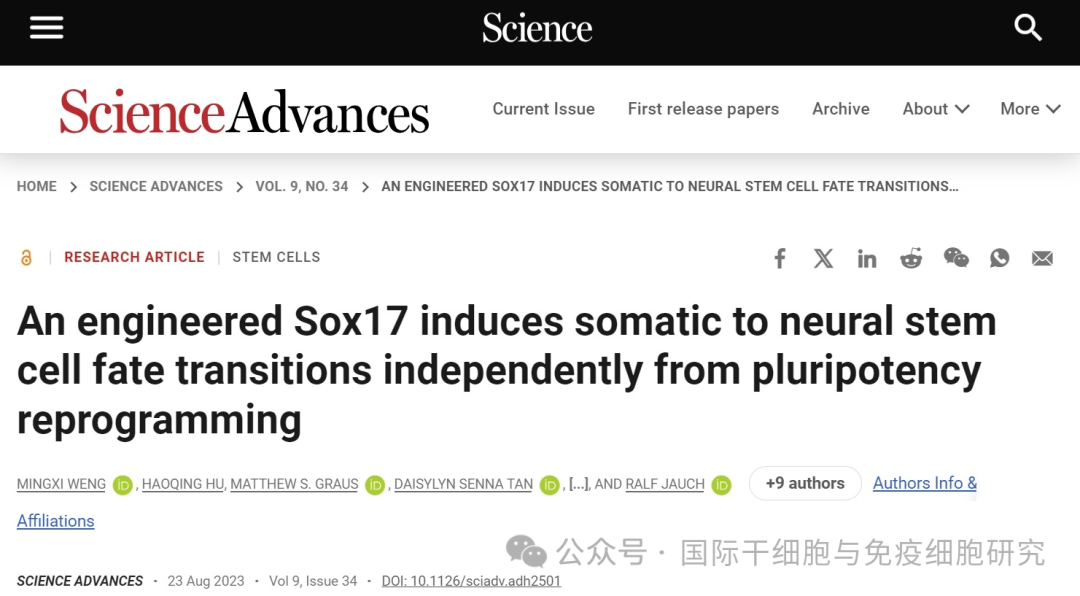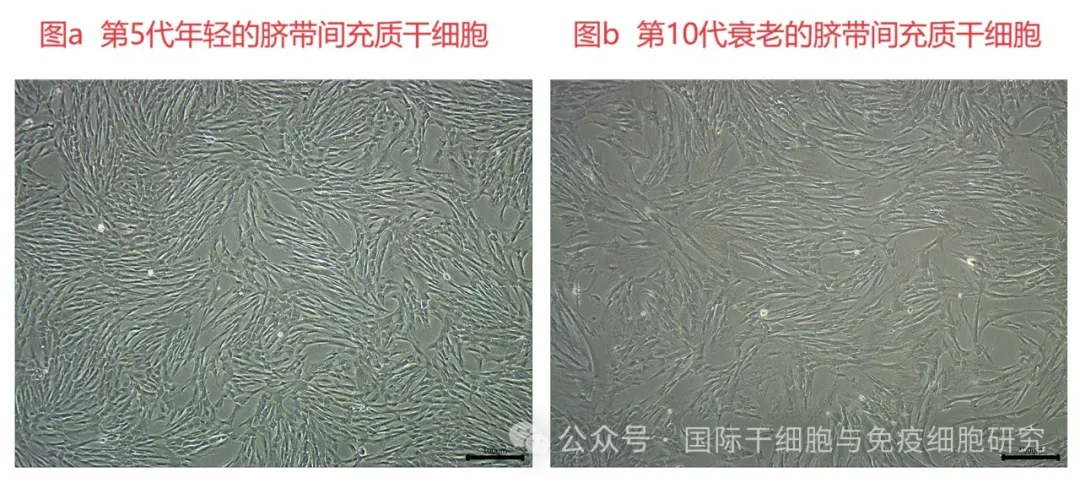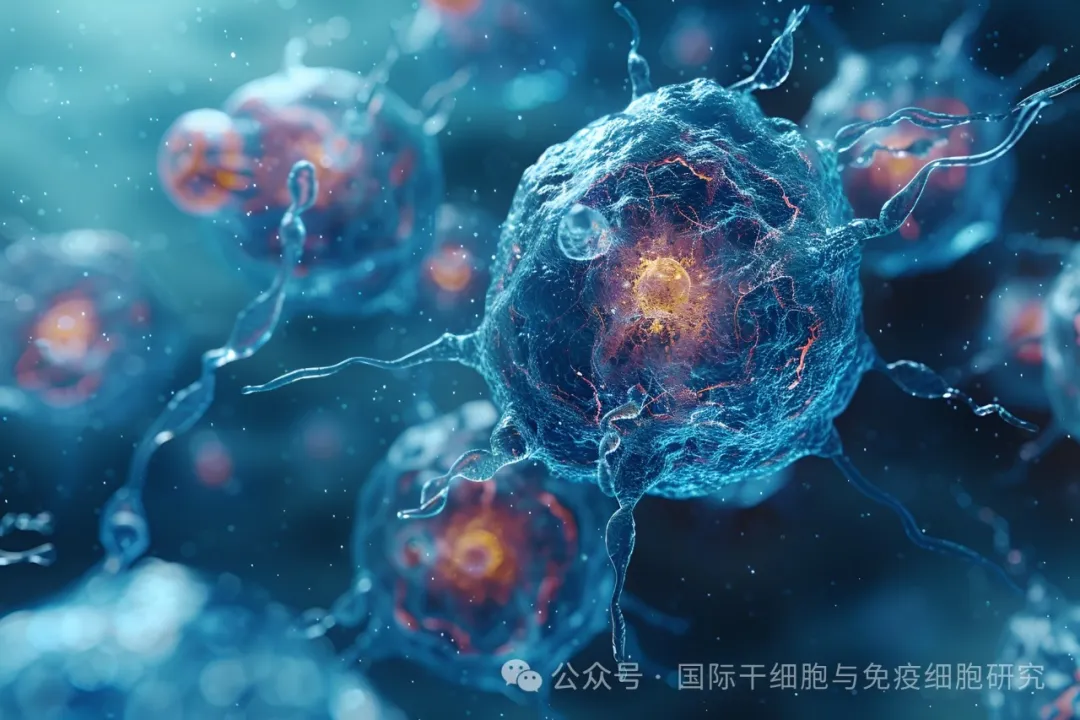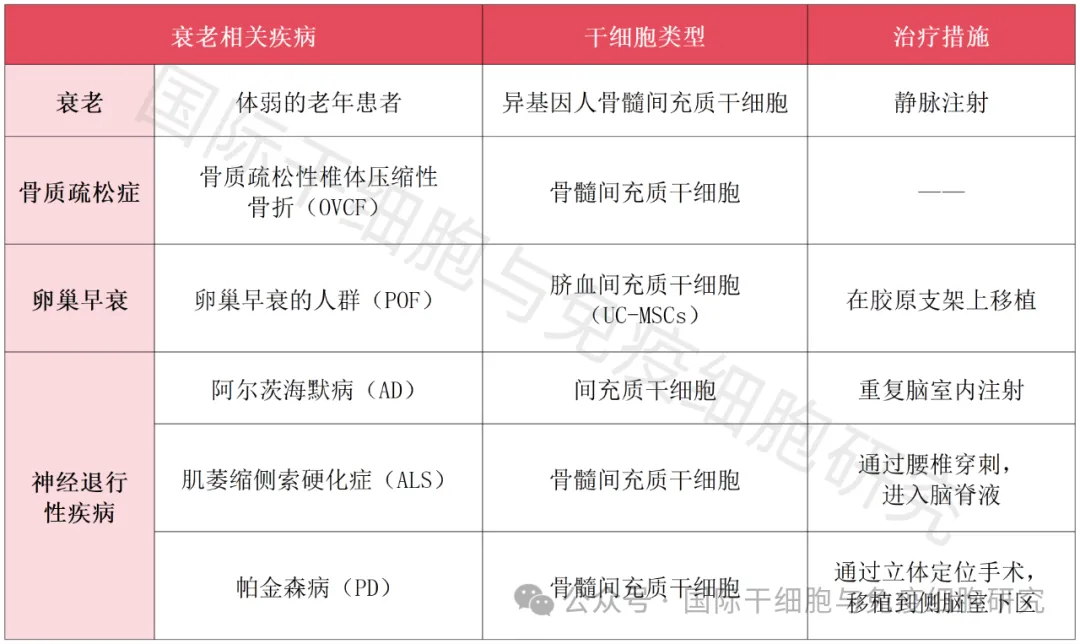
The research team at the School of Biomedical Sciences of the University of Hong Kong Li Ka Shing School of Medicine (hereinafter referred to as the "HKU School of Medicine") has recently made breakthroughs in the field of stem cell research. The team has developed an innovative method to convert blood and skin cells into neural stem cells. The emergence of this research result, on the one hand, overcomes the limitations of current stem cell research technology; on the other hand, it provides new options and hopes for the treatment of age-related diseases (such as Parkinson's disease, Alzheimer's disease, amyotrophic lateral sclerosis, etc.), and relevant research results were simultaneously published in the world-renowned journal Science Advances.
HKU School of Medicine: Exploring shortcuts to the research and development of neural stem cells to treat age-related diseases

▲Screenshot from "Science Advances"
The human body is made up of more than 200 different types of cells, each of which plays a key role in maintaining overall health. However, acquiring and analyzing certain special types of cells, such as neurons located deep in the brain, has been difficult. In addition, traditional induced pluripotent stem cells (IPS) and embryonic stem cells often cannot fully capture the characteristics of aging cells, limiting their application in the treatment of age-related diseases.
In order to deal with these limitations, the HKU School of Medicine team converted a powerful molecule called "SOX17" into a "super stem cell factor", making it self-organize within the nucleus and accurately navigate from one gene to another. Gene, thereby achieving rapid and effective cell transformation. At present, the team has submitted a non-provisional patent application on the use of engineered SOX17 to develop next-generation stem cell models, and retains aging stem cells, providing a more reference for studying potential treatments for age-related diseases. Data, the next phase will focus on nerve cells produced in the blood cells of the elderly.Aging science
Aging refers to the gradual degradation of the body with age, manifested by the accumulation of aging cells and inflammatory factors, which leads to the occurrence of various aging-related diseases, such as neurodegenerative diseases, osteoporosis, premature ovarian failure (POF), Cardiovascular disease (CVD), etc.
Aging is usually accompanied by cellular aging, which is a key mechanism of aging. In addition, endogenous stem cell depletion may also be involved in the aging process. Compared with young mesenchymal stem cells (MSC), aging mesenchymal stem cells (MSC) experience reduced cell activity, reduced immune regulation ability, and reduced ability to secrete factors (such as anti-inflammatory factors, growth factors, etc.). In addition, the shape of aging cells will also change. For example, as umbilical cord mesenchymal stem cells (hUC-MSCs) age, the cell shape can change from a slender spindle shape to a large, flat shape (see the figure below for details).

▲Picture source "PMC"
How to delay aging?

Current research has found that cell therapy, represented by mesenchymal stem cells, is a potential treatment method to delay and combat aging-related diseases. In addition, appropriate nutritional intervention, strengthening exercise, caloric restriction, maintaining iron homeostasis and other methods can also help delay the aging process to a certain extent.
Cell therapy fights skin aging
As the barrier of the body, skin will undergo aging or pathological changes with aging. Skin condition is also one of the intuitive manifestations of aging, which may be caused by the accumulation of aging cells, the loss of collagen, and the increase in matrix metalloproteinases and oxidative activities.
Studies have shown that mesenchymal stem cells (MSC) are pluripotent cells that can produce mesenchymal and non-mesenchymal tissues in vivo and in vitro, and have the ability to self-renew and multi-directional differentiation. MSC can secrete factors needed for skin regeneration, inhibit the expression of matrix metalloproteinases, and increase collagen synthesis. It has good application prospects in skin regeneration.
In addition, ultraviolet light is also one of the key factors causing skin aging. It can easily damage the dermal layer of the skin and destroy fibrous tissue. The resulting aging problem is also called "photoaging". Mesenchymal stem cells can promote skin regeneration by increasing cell proliferation and new blood vessel formation. In addition, it can also prevent aging problems caused by ultraviolet rays by regenerating tissue structures and producing collagen and elastin fibers.
Cell therapy fights hair problems caused by aging
Hair loss and gray hair are also one of the direct manifestations of aging. Among them, hair loss is related to the degeneration of hair follicles. Although it can currently be treated by surgery (such as hair transplantation) or drugs (such as minoxidil), its efficacy is limited and is not suitable for all patients, and there are certain side effects. Therefore, there is an urgent need to develop more effective methods to treat hair loss.
Studies have shown that mesenchymal stem cells (MSC) have the ability to migrate, home and differentiate, and have paracrine effects. They can release a variety of nutritional factors (such as cytokines, growth factors, etc.) and play an important role in hair regeneration and repair. Common stem cells that can be used for hair loss treatment are as follows:
1. Bone marrow mesenchymal stem cells (BMSC): It can promote the proliferation of hair follicle stem cells (HFSC) and transform hair follicles from resting stage to growing stage, thereby promoting hair follicle regeneration and hair growth.
2. Umbilical cord mesenchymal stem cells (hUC-MSC): Have the ability to protect hair follicle dermal papilla cells and treat hair loss.
3. Other stem cell cells: such as hair follicle mesenchymal stem cells, pulp mesenchymal stem cells, fat mesenchymal stem cells, amniotic fluid mesenchymal stem cells, etc., can also accelerate hair regeneration and have a certain therapeutic effect on hair loss.
Cell therapy fights immune aging

Aging can lead to the aging of the immune system, destroy the homeostasis of macrophages, and increase the morbidity and mortality of the elderly. This phenomenon is called immune aging. As life expectancy increases rapidly in the elderly, the immune system has gradually become the main driver of age-related diseases. Immune system aging is a dynamic and gradual process. Studies have shown that after the age of 30, the activity of the thymus will decrease year by year at a rate of 2% to 3% per year, resulting in a significant decrease in the activity of individuals aged 50 to 65. Although the aging thymus will continue to exert immune functions, T Cell production is significantly reduced, and its effect may be greatly reduced. For example, neurodegenerative diseases, cardiovascular diseases, osteoporosis, etc. are all common diseases related to aging.
Therefore, how to rebuild or improve the body's immunity is one of the important means to fight aging-related diseases. In recent years, research has found that cell therapy can help offset immune aging and age-related immune dysfunction. There are two main ideas for interventional immune regeneration strategies. One is to focus on regenerating aging immune organs to restart the patient's immune system; Second, directly rebuild the immune system by artificially replenishing cells, microenvironments or tissues. The following takes stem cells and NK cells commonly used in clinical practice as examples to briefly introduce how to improve the body's immunity through cell therapy.
1. Mesenchymal stem cells (MSC)
Mesenchymal stem cells (MSC) have unique immunoregulatory capabilities and participate in tissue regeneration and maintaining internal balance.
On the one hand, it can directly affect innate and adaptive immune cells (such as NK cells, DC cells, macrophages, B lymphocytes, and T lymphocytes) to restore immune homeostasis.
On the other hand, mesenchymal stem cells are known regulators of thymus degeneration, regulating the structure and activity of the thymus and preventing, slowing or reversing the process of thymus degeneration.
2. NK cells
Natural killer cells (NK) are the core cells of natural immunity. They always patrol the blood vessels of the whole body and exercise immune surveillance functions. They will discover and eliminate cancer cells, infected cells, and aging cells as soon as possible. Therefore, they are also known as the body's first line of defense against cancer and infection, and play a key role in clearing tumors and fighting infections.
NK cells can also serve as a key regulator of adaptive immunity because they regulate adaptive immunity by targeting dendritic cells; they can also activate and recruit components of innate and adaptive immune responses by releasing chemokines, inflammatory cytokines, cytolytic particles, etc.
Cell therapy improves premature ovarian failure (POF)
Premature ovarian failure (POF) is a common endocrine disease that can lead to female infertility. Its incidence may be related to multiple factors such as autoimmunity, genetic defects, chemotherapy damage, and age. As we age, most follicles are exhausted and ovarian function is impaired, which can eventually lead to premature ovarian failure. Currently, hormone therapy is the main method, but this method cannot restore ovarian function.
The emergence of stem cell therapies has brought new hope to patients with premature ovarian failure. Studies have shown that mesenchymal stem cells have an immunomodulatory effect, increasing the release of anti-inflammatory factors and inhibiting the production of pro-inflammatory factors, thereby helping to promote follicle survival and improve premature ovarian failure.
A study on "Umbilical cord mesenchymal stem cells (UC-MSC) for the treatment of premature ovarian failure" divided the enrolled patients into two groups, namely, a stem cell treatment group (receiving UC-MSC transplantation) and a combination treatment group (receiving UC-MSC combined with collagen transplantation). After a one-year follow-up, the results showed that mesenchymal stem cells have a good effect in treating premature ovarian failure. Among them, UC-MSC improves the activation and growth of follicles; while UC-MSC combined with collagen transplantation contributes to the long-term recovery of ovarian function and improves the fertility of patients to a certain extent.
Cell therapy improves neurodegenerative diseases
As aging progresses, the incidence of some neurodegenerative diseases (such as Alzheimer's disease, Parkinson's disease, etc.) also increases. Aging is one of the main risk factors for neurodegenerative diseases.
Studies have shown that mesenchymal stem cells (MSC) have the ability to migrate and homing and play a role in the aging brain; in addition, neural stem cells (NSC) can produce new neurons that help improve the function of the central nervous system.
Cell therapy improves osteoporosis
Osteoporosis is an age-related progressive systemic bone disease characterized by low bone mass and high bone fragility. In patients with osteoporosis, MSC's ability to differentiate into osteoblasts is reduced, but its ability to differentiate into adipocytes is increased, ultimately leading to reduced bone formation. Although some drugs help treat the disease, they are not effective in all patients and may also produce adverse reactions. Therefore, new treatments are urgently needed.
Recent studies have shown that mesenchymal stem cells (MSC) not only secrete factors involved in bone repair, but also have the ability to differentiate into osteoblasts, chondrocytes, and adipocytes. Therefore, MSC can be used as an alternative therapy for age-related osteoporosis and has broad application prospects in the treatment of osteoporosis.
▼Clinical study of mesenchymal stem cells in the treatment of aging-related diseases

▲Data from "Stem Cell Res Ther"
Summary
Aging not only affects our appearance, but may also cause a variety of age-related diseases, such as hair loss, neurodegenerative diseases, osteoporosis, premature ovarian failure, etc., which is harmful to the human body. Therefore, it is of great significance to deeply understand the causes of aging and explore more effective measures to delay or even reverse aging.
In recent years, research has found that with the development of regenerative medicine, cell therapies represented by stem cells have broad application prospects in the field of anti-aging, helping to delay aging, fight aging-related diseases, and enhance the body's immunity. It is gratifying to note that there are currently some clinical trials based on stem cells to treat aging and aging-related diseases, which have initially proved the effectiveness and safety of cell therapy.